District & school administrator toolkit
This complete toolkit for literacy change will help you bring trusted, proven, and efficient teaching methods, ongoing professional learning and support, and turnkey instructional resources to your teachers and students. Get ready to implement supported, sustainable science of reading instruction in your district.

“Transformative change requires being unafraid to act on your convictions, having a vision of what is possible and really important, and not giving up when the going gets rough if you know that what you are pursuing is right and valuable.”
Louisa Moats, EdD | Author, Speaker

The tools you need to lead literacy change
This toolkit was designed with you, the decision maker, school leader, and implementation overseer, in mind. We know how much you have on your plate. We also know that doing everything you can to ensure the success of the children in your school or district is at the heart of why you do this work.
This web resource designed exclusively for school leaders will give you:
A trusted research base
Curated reports and specific examples of how evidence-aligned instruction can help move all students forward.
Resources on how to maximize funding
From using existing federal and state funding to getting creative in their respective communities, check out how district leaders have tapped into existing resources to ensure they could fund the necessary changes.
Guidance on efficient implementation
Wide-scale change is a marathon, not a sprint. Read about the steps necessary for sustainable, long-term literacy change to take root and thrive in your community.
Success stories from schools and districts
Check out stories about and interviews with leaders who trusted the process, took the time to get it right and have the results to prove that with the right resources, we can unlock literacy for all.
Transformational change takes courageous leadership
Navigating the change required in a school community can be challenging. Whether you are just getting started or are ready to purchase an evidence-aligned, easy-to-implement literacy ecosystem for your district, we’ve got you covered.
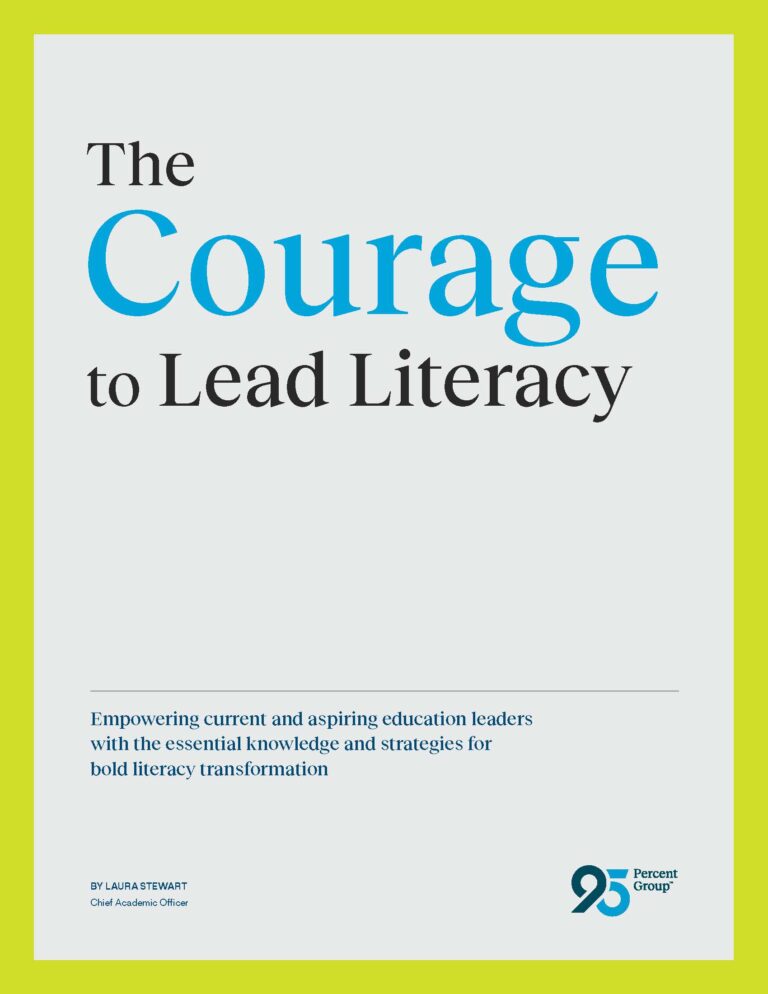
Make change happen
Our new book is here! In The Courage to Lead Literacy, Laura Stewart and leading literacy changemakers share with you essential knowledge and strategies for bold literacy transformation. Get your blueprint for sustainable change and get ready to “make it happen.”
What we’ve done in Fulton County is train our teachers in the science of reading and given them the tools that are aligned with the science of reading—one of the major tools we’ve implemented is 95 Phonics Core Program®.
Mike Looney, District Superintendent
Every Child Reads: Fulton County
Fulton County had many schools that were not producing strong readers. Something needed to change, and it did. With careful planning, focused use of funding, and collaborative work among visionary school leaders and teachers, change is happening. And it is only year one of using the One95 literacy ecosystem.
Bridging knowledge and practice
The science of reading 2.0 is bridging the science of reading with the science of learning and implementation science. During this webinar, we explore how to implement the transformational change required for leaders and educators to move forward and unleash the power inherent in the science of reading.
The leader’s first priority in leading transformative change in literacy is to create a team of diverse and invested parties to ask those big questions and take those bold steps.
Guiding principles of courageous literacy leadership
Two stars from our Courageous Leaders webinar series, Danielle ‘Nell’ Thompson, PhD, CCC-SLP, and Terrie Noland, PhD, CALP, explain why literacy leadership matters and how to make the most of it in today’s education landscape.
What schools need to know about the science of reading
With so much talk about the science of reading and the way it has made comprehensive literacy acquisition accessible to all students, it’s likely you have come across these ideas before. You might already be familiar with the foundations of the evidence, or you might just be getting started. Either way, our ebook, published last fall, is your one-stop shop for everything you need to know about the science of reading, and why it matters so much at this moment.
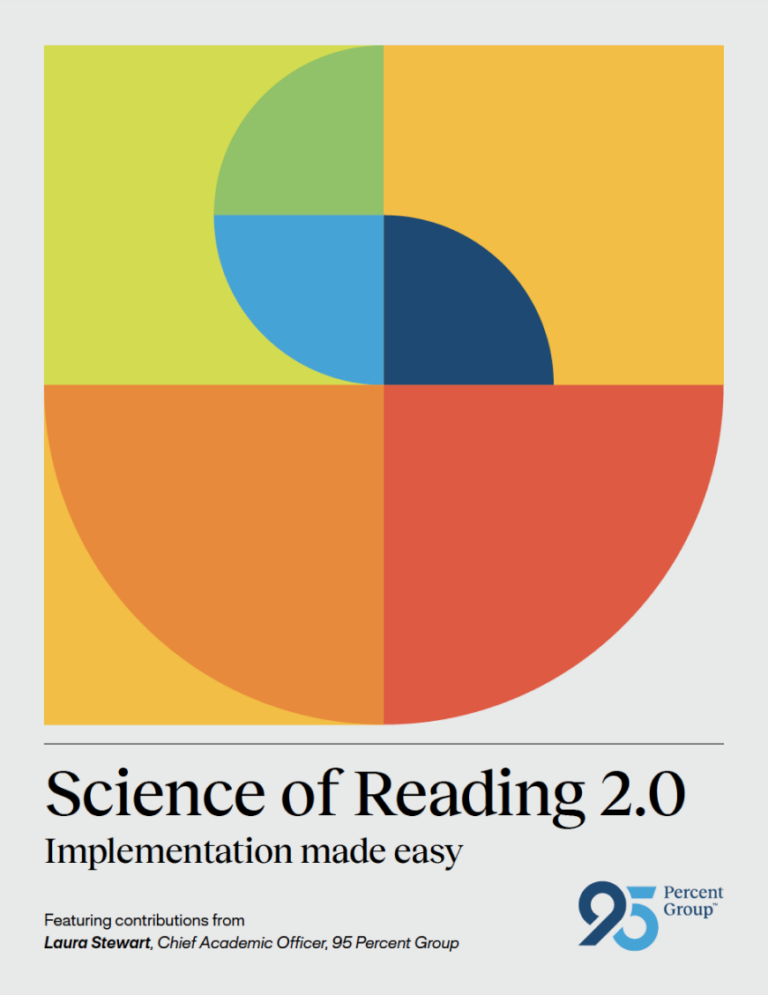
Introducing the Science of Reading 2.0
The next generation of the science of reading connects research about reading and learning to help educators implement effective literacy instruction. Unlock the power of literacy for your students with this easy-to-use guide.
The science of reading, explained
Learn about the two proven aspects of reading success—word recognition and language comprehension—and the science of implementation.
Principles of effective literacy instruction
Discover the 10 trusted steps for bringing effective instruction to your students, combining methods from the “I do, we do, you do model” with Rosenshine’s principles of instruction.
Stories from the field
Get inspiration from other educators, with real-world case studies about the impact of the science of reading in classrooms around the country.
Administrators are a very important piece to this. We need administrators that are knowledgeable in the science of reading, who are looking at and using their data. They have to be willing to follow their passion and create a change at the school site level in the culture and in what their teachers are doing inside the classroom.
David Mack, EdD, Chief Administrator of Business Services
Evidence-based brings equity
We now know that when teachers engage their students with structured, direct, and explicit instruction that’s proven to be effective, every student is empowered to learn to read. This matters because when children receive highly effective reading instruction it greatly improves their opportunities for a productive and secure future.
Research in literacy education: Why evidence matters
Read about how the extensive body of knowledge that exists today provides a foundation for best practice and effectiveness for any curriculum, product, or intervention.
That year, none of our students ended up qualifying to go into Tier 3 intervention because we were able to provide the data to show that the interventions we were doing with the Phonics Screener for Intervention™ and 95 Phonics Chip Kits™ were helping them to achieve their goals.
Spotlight California: Driving systemic literacy change
Read about one district’s journey highlighting the importance of evidence-based, data-driven instruction, ongoing support, and a commitment to equitable education for all students.
77%
Research in action
See a snapshot of some of our research highlights, completed by an independent, third-party research partner, and discover why it is so critical that 95 Percent Group’s literacy resources are both evidence-based and evidence-aligned.
209%
Spotlight Pennsylvania: One district’s journey to transformational literacy change.
We were very strategic about developing a plan of action with change because we both feel very strongly that change cannot occur immediately. It has to be well thought out, and you have to have the end in mind.
BRIAN CROMER, DIRECTOR OF CURRICULUM, INSTRUCTION AND ASSESSMENT South Western School District, PA
Navigating alignment to state legislation
More than 40 states have recognized the power of the science of reading by adopting policies that support helping readers build the foundations and advanced skills of language in a structured progression. With current national momentum for literacy instruction grounded in the science of reading, states are enacting laws designed to expand access to evidence-based reading instruction and to equip teachers with the skills needed for district-wide, school, and student success.
Literacy rising in Mississippi
Watch our webinar about two key structured literacy leaders who share the long view of literacy in Mississippi and how they worked to raise literacy achievement for all students.
Every state needs an independent voice that can push for change, say things the state agency people cannot (or are reluctant) to say, test ideas and methods, shine a light on problems, and devote resources to solving them…essentially, set a high bar for change and hold the system accountable.
Research summary
View a summary report on efficacy studies that show how 95 Percent Group builds on science to empower teachers—supplying the knowledge, resources, and support they need to develop strong readers.
District buy-in: Relentless communication
With current national momentum for literacy instruction grounded in the science of reading, an increasing number of states are enacting laws designed to expand access to evidence-based reading instruction and to equip teachers with the skills needed for district-wide, school, and student success. Through rigorous third party independent research findings, students using products from 95 Percent Group’s One95 Literacy Ecosystem™ have been observed to be more engaged and independent throughout the reading block. And they experience accelerated reading improvement.
Asking educators to leave behind a familiar method in order to begin something new is a challenging task. By offering those who teach reading the opportunity to understand the process and what’s possible for both their teaching practice and their students’ growth, you increase the likelihood that they will champion the initiative.
Best practices for Tier 2 literacy (Part 1): Lessons learned from a California school district
Check out this interview (part 1 of 2) with David Mack, EdD, Chief Administrator of Business Services, and Charley Clark, Assistant Superintendent discussing the successful Tier 2 implementation that catalyzed Fairfax School District’s structured literacy journey.
Once we started shifting our mindset to ‘They’re our kids and not my kids,’ teachers were more willing to talk about data. You get the class that you’re dealt. You can’t control how they come in. You certainly can control some things that impact their growth. Once we overcame that hurdle, everyone was more willing to discuss data.
95 Percent Group experts corner
An interview with Kelly Butler and Kymyona Burk, EdD, about how a group of dedicated people with a long range vision and commitment turned literacy in Mississippi around. Yes, Mississippi’s success CAN be replicated to raise literacy achievement for all students.
Funding systemic literacy change
Districts continue to figure out the best way to fund new and important curriculum changes even as ESSER and Pandemic Recovery funds begin to phase out. See how these leaders got creative and tapped into the resources the community already had.
Best practices for Tier 2 literacy (Part 2)
Discover essential mindset shifts in Part 2 (of 2) of our Fairfax School District interview, offering best practices for funding a successful Tier 2 implementation of structured literacy.
We can do everything. We just can’t do it all. It really depends on what your priorities are. And then, if it’s important to you, you’ll find the money for it. You may have to cut something else, but you take care of your priority.
Spotlight Pennsylvania: Courage, leadership light the way for literacy change
Transformational change takes courage and a laser focus on doing what’s best for students. Despite challenges, Robert Palazzo, principal at Panther Valley Elementary School in Pennsylvania, boldly made the decision to bring change, and found the resources in his community to help do so.
Culture change: Leader transparency
Transformational change sometimes requires taking a hard look at school culture. Although the culture of a school system is one that’s often built over time, the truth is that educators want what’s best for their students. With honest communication and total leadership transparency about the Why behind the changes, rapid improvements in culture can bring about a sturdy foundation for sustainable change.
Empowering 4th and 5th grade students with foundational phonics instruction
South Western School District launched 95 Phonics Core Program in the fall of 2023, after a years-long, district-wide literacy transformation plan—one that required bold decision making and, ultimately, trust in the steps that would move them forward. One of the challenges they were hoping to address was the lack of strong foundational literacy instruction, not just in grades K-3, but also in grades 4 and 5.
“It comes down to having a vision with patience and clear, strategic communication. For the vision, you have to know where you want to go and always be looking to the horizon. And then have patience. Take the time to get the right team in place, people that will hold the vision as their own over time.”
Trust in the process: How phonics instruction is changing the game in Arizona
District leaders in Flagstaff, AZ, knew they needed a high-quality, evidence-based phonics program that would empower teachers to provide students with instruction that is explicit, sequential, systematic, and comprehensive. Read their story here!
Spotlight California: Research-based best practices for implementing a Tier 1 phonics program
Fairfax School District is located in a small community on the southeast side of Bakersfield, in Kern County, California. The district currently has four schools (they’re adding a fifth) with a total of 2688 students. Here they share best practices in implementing the science of reading.
You have to be able to tell your story about why a new program is important to get the buy-in. If you don’t have a story and you just say, ‘because it worked over there,’ it’s not going to be effective. You have to model it yourself and show the importance of it, your excitement about it. That’s how you change the culture.
David Mack, EdD, Chief Administrator of Business Services Fairfax School District
A literacy ecosystem to unlock the power of reading
When asking educators to make a change in their foundational literacy approach, it’s important to put something in their hands that makes sense. With our One95 Literacy Ecosystem™, teachers and interventionists alike can breathe easily knowing that the engaging scripted, turnkey resources and common language across the instructional tiers will help everyone to get into solid routines quickly. They can map instruction directly from the diagnostic assessment to the student’s precise skill level.
Everybody uses the same language: decoding the same way and using the same movements: finger stretching or word mapping. So no matter who they work with, students are all using the same language and movements. The teachers and staff love the common language, and it’s taken a cognitive load off our students because they don’t have to reset their routine depending on who’s teaching.
Spotlight Illinois: Schoolwide literacy growth with core phonics instruction
Check out this story for insights on why having a core literacy curriculum and a common language across instructional tiers matters. Read the full story for more about how Principal Holly Davis-Kitson and her team at Parsons Elementary have launched a movement in their district.
“The most equitable thing that we can do is to make sure our kids leave our buildings reading and being able to do this work. Because if they cannot read when they leave this building, then we have not done them justice.”
Spotlight Georgia: Watch Fulton County
Every child deserves the right to read. Read about how Superintendent Dr. Looney and his school teams turned to 95 Percent Group to ensure that all students in Fulton County could receive the science-based literacy instruction they deserved.
92%
Discover the One95 Literacy Ecosystem
The time for urgency in literacy instruction is now. The One 95 Literacy Ecosystem™ offers aligned instructional materials across all tiers of instruction—all backed by rigorous efficacy studies. Check out this piece on the blog to learn more!
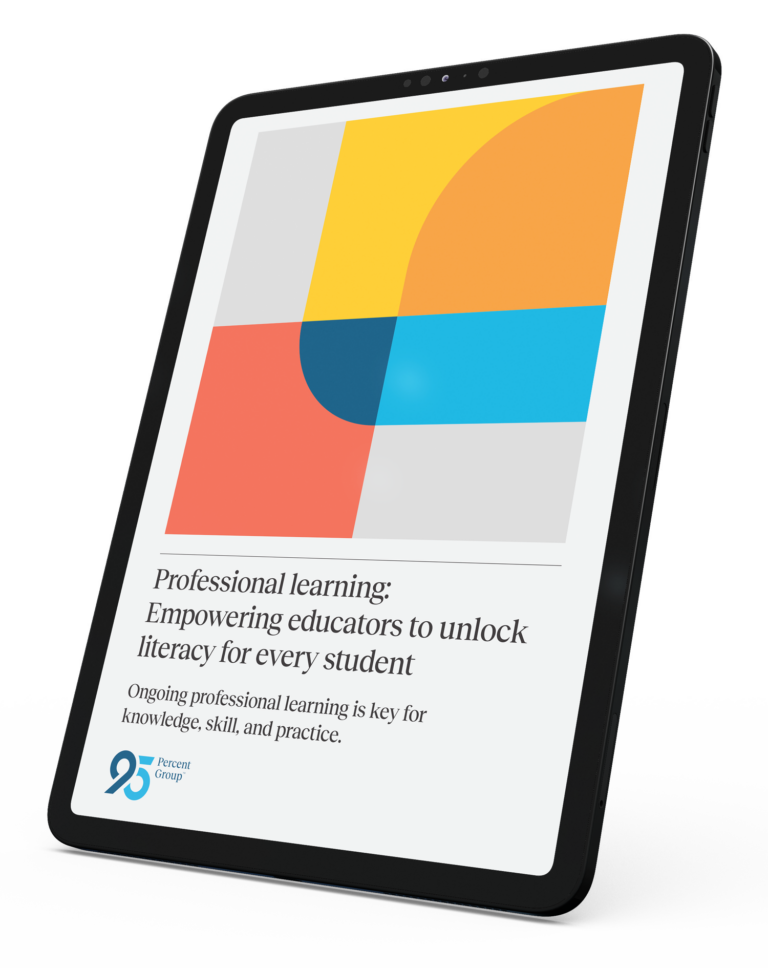
Professional learning: Empowering educators to unlock literacy for every student
Bring research to practice—and bridge what you know with what you do. Learn with 95 Percent Group and develop the knowledge and practices you need to implement our trusted methods and build upon the science of reading in your classrooms. We create a curated, professional learning services plan that uniquely meets the specific needs of each of our school customers. Read our new eBook, “Professional learning: Empowering educators to unlock literacy for every student,” and discover the opportunities we have for you.
Get to know the only science of reading course you need
We needed something that was relatively cost-effective, that was asynchronous, that would allow our teachers to do it in bite-sized pieces. We also like the videos and the research coupled with some takeaway tools that you could try out—so it checked all the boxes for us in terms of full scale implementation…I haven’t seen a professional development tool that can change teacher knowledge in such a profound way that’s asynchronous and affordable.

Casey Bertram, Superintendent Bozeman Public Schools, MT
Spotlight Colorado: Professional learning helps close the literacy gap
Tasked with improving student literacy achievement at her school, Dalton Elementary School Principal Jessica Abel-Pype recognized the transformative potential of the evidence-based, structured literacy resources from 95 Percent Group. After partnering with 95 Percent Group and its literacy coaches, Dalton Elementary School began experiencing a significant rise in school performance and student literacy.
Coaching has provided classroom teachers and educators with a deep understanding of the vision for what each lesson should look like, their role in the lesson, and what they should expect from their students. When teachers have a deep understanding, effectiveness increases, and it shows in student achievement and data.
Jessica Abel-Pype, Principal Dalton Elementary School, CO
Learn more about how 95 Percent Group’s resources and wrap around services can support your transformational literacy change!
Looking for more information? Check out some of these additional resources on the science of reading and its implications for teaching and learning literacy:
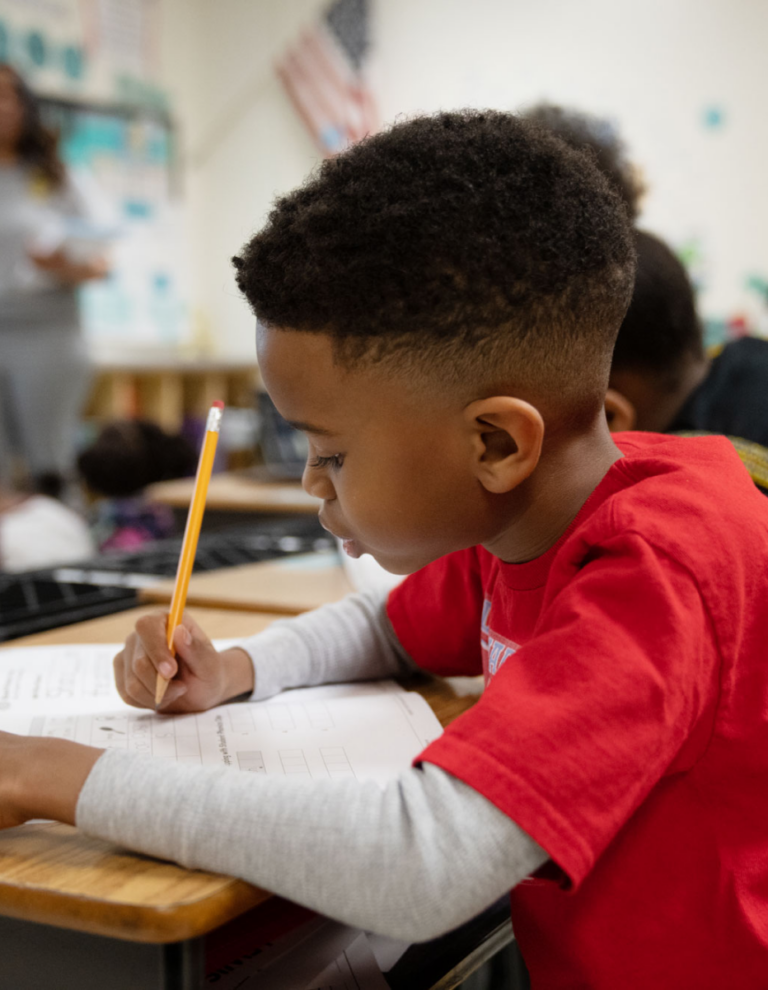
Frequently asked questions
Here are the two top questions educators ask as they begin their science of reading journey. Explore our FAQ page or get in touch for more information. We are here to help you.
How does the science of reading help students learn to read?
The science of reading is the current body of evidence on how children learn to read. A structured literacy approach, based in the science of reading, is the best approach for nearly all children. The evidence we have is consistent and overwhelming: we know that explicit and systematic phonics instruction typically leads to better outcomes in learning to read.
What does the science of reading replace in education today?
It replaces reading practices and theories—such as three cueing, balanced literacy, and whole-language instruction—that have been proven false. For example, there was a pervasive concept that children should use pictures or context to guess at an unknown word. That is not an effective and efficient route to word recognition; utilizing decoding, however, is an efficient and effective route to word recognition. Another pervasive and persistent idea is that there are hundreds of ways to learn to read, and no set of instructional principles that will be the most effective for most children. These are just not true, and the science of reading has helped to shine a light on that.
One solution for literacy instruction
Based on the science of reading and backed by nearly two decades of research, the One95 Literacy Ecosystem™ is proven to advance reading skills in students from diverse backgrounds, grades, and abilities.rnrnIt integrates evidence-aligned products and professional learning resources into one cohesive system for instruction across tiers—so you’re ready and able to help every child realize their reading potential.
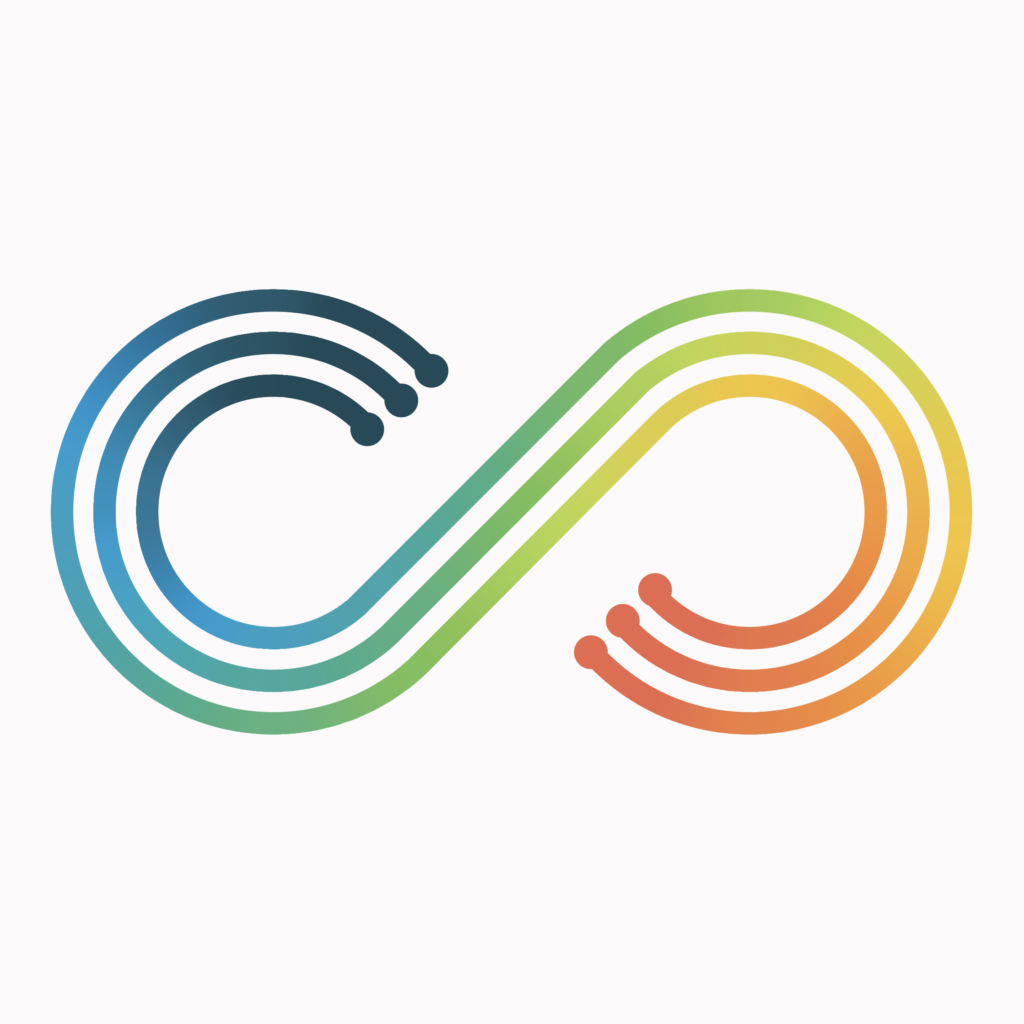
95%
or more of students can learn to read with high-quality, evidence-based instruction.

Putting reading research into practice
Today, we know a great deal about what works in reading instruction thanks to the science of reading. But our work as educators doesn’t end there—effective implementation is essential. Implementation science bridges the gap between research and real-world practice, providing insight on how to realize literacy success.
Evidence-aligned resources
Enhance outcomes with the right instructional materials, at the right time, backed by high-quality research.
Instructional practices
Follow best practices for literacy instruction to help students stay engaged, develop new skills, and become independent readers.
Strategic coaching
Provide feedback and support to help educators build knowledge, confidence, and instructional ability.
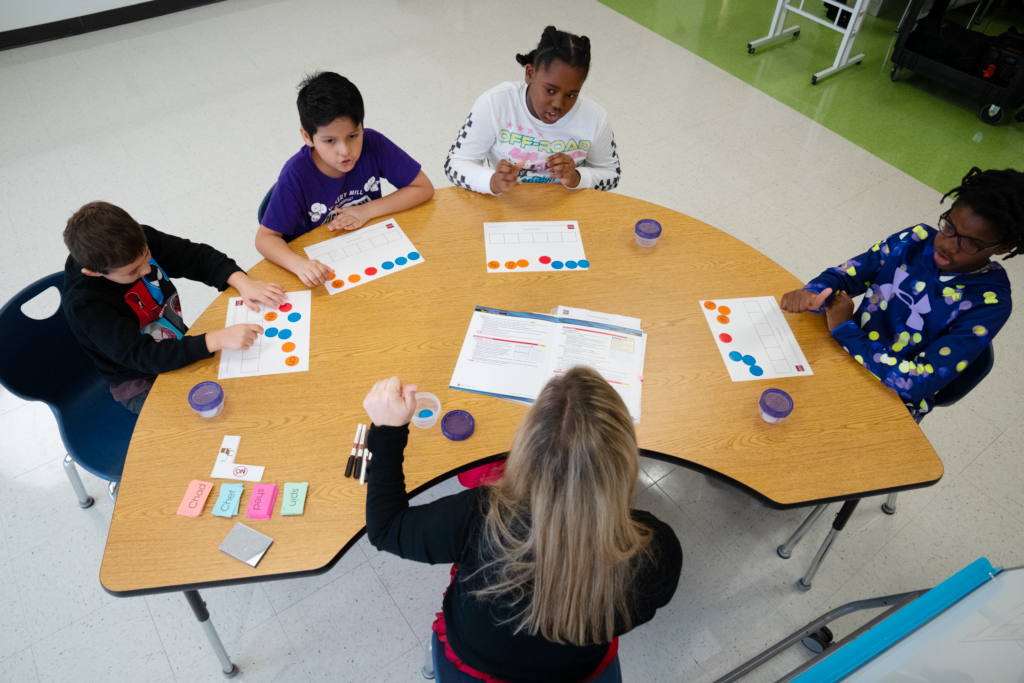
Build your expertise
Improve your instructional practices, get support through ongoing coaching, or attend an upcoming workshop or webinar with experts in the Science of Reading.
60%
of elementary teachers have never been trained in strategies for teaching phonemic awareness, phonics, vocabulary, fluency, and comprehension (EAB Report on Literacy).


